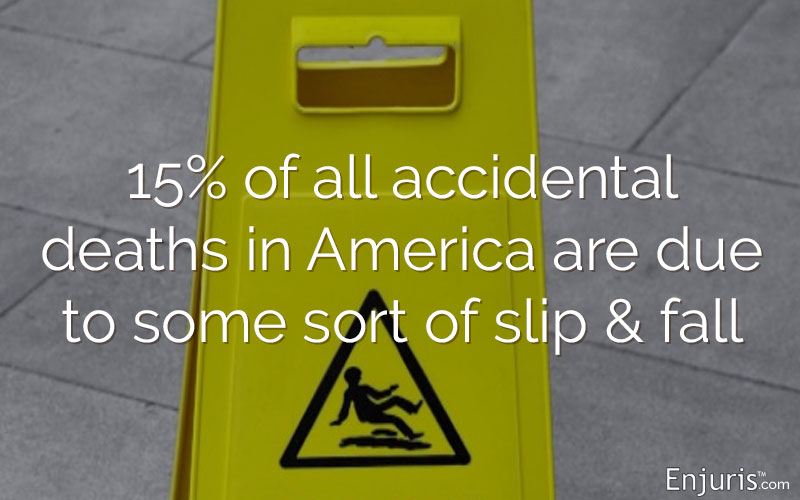Colorado guide to slip and fall accident laws
Slip and fall incidents are considered the “frequent fliers” of personal injury cases.
It seems straightforward: You stepped in a puddle, you slipped and you fell.
That puddle could have been an icy patch, a banana peel, a dog’s leash or any number of things, but the end result remains the same. You fell and you injured yourself, maybe severely.
Slip and Fall Accident Facts
- Women are more likely to suffer from a slip and fall.
- More than one million emergency room visits per year are prompted by a slip and fall.
- They also cause half of all accidental deaths each year.
- Slip and fall accidents make up 12% of total falls.
- Slip and falls are also the primary cause of days missed from work.
- Compensation and medical costs for employee slip and falls: Approximately $70 billion annually.
Considering the number of things in existence over which a person can trip, these are very popular cases. Lawyers can make quite a good living doing nothing but “faller downers,” as some attorneys like to call these.

Checklist of 30 items to help you prepare for making a personal injury or accident claim
Download in PDF format
They are a type of premises liability case in which the property owner negligently failed to maintain the premises, resulting in an injury to another party.
We can joke and make light about slipping on banana peels, but these are actually serious accidents. They can result in lacerations, broken bones, concussions and even death.
Tweet this
Women are more likely to suffer from a slip and fall, according to the Bureau of Labor Statistics. These types of accidents account for more than one million emergency room visits per year, which comes to 12% of total falls. They also represent the primary cause of days missing from work and half of all accidental deaths each year. As for compensation and medical costs for employee slip and falls? Approximately seventy billion dollars annually. It’s a big market, and as the elderly keep tripping and falling, the market only becomes bigger.
What if you live in Colorado? How does that state handle this type of case differently than the rest of the country?
Slip and fall accidents in Colorado
As mentioned above, slip and falls are a type of premises liability. The Colorado Premises Liability Act, called the PLA, governs these accidents and helps plaintiffs recover damages.
When you decide to go onto a business or commercial property, you are labeled as an “invitee” by the court system. This means that businesses must use reasonable care to prevent injuries from occurring to you while you handle your transaction there. If the business fails to do this, it’s potentially responsible for any injuries that happen to you.
If you walked onto their property to buy some skis and slipped on an icy patch, banging your head on the ground, the business would likely be responsible for not taking care of the ice. The business owner would have had to know about the ice and neglected to take care of it; it was his responsibility to remove it and he did not. This would be the case if you fell at the edge of the parking lot or inside the establishment. The business would responsible for paying damages.
Proving a slip and fall case in Colorado
While it’s very hard to keep a level head after it’s been banged on the floor, try to think clearly. You need to preserve the accident scene. Slip and fall cases are difficult to prove at the best of times, and businesses will have every incentive to mitigate the damage.
Photograph the scene if you can, as well as any damage to your person. Examples of slip and fall or premise liability accidents would be wet or icy patches, icy parking lots that are covered in snow, potholes in pavement, loose rugs, inadequate lighting or poorly maintained steps. You will want photographic evidence of anything related to how you fell, and your attorney will thank you profusely.
Once you have that information, connect with a Colorado premises liability attorney. He or she can help you through the process. Considering the statute of limitations for a personal injury claim in Colorado is only two years, you will want to begin the process sooner rather than later. The clock starts running on the date of the accident. If the claim is against the government of Colorado or some other form of official municipality, the time limit is 180 days.
Make sure to include all doctors’ notes and insurance papers, should you require medical attention after the slip and fall.

Sample accident journal/diary to help you document the effect on your daily life
Download in PDF format
Remember that Colorado is a comparative fault state, meaning that the business owner can turn around and claim that you were somehow partly responsible for the accident. You might not think this could fly in a trip and fall case, but under a modified comparative fault rule, you might be found 10% guilty for not looking where you were walking before hitting the icy patch.
Need an attorney to help you sort this out? Check out the Enjuris law firm directory!
See our guide Choosing a personal injury attorney.


